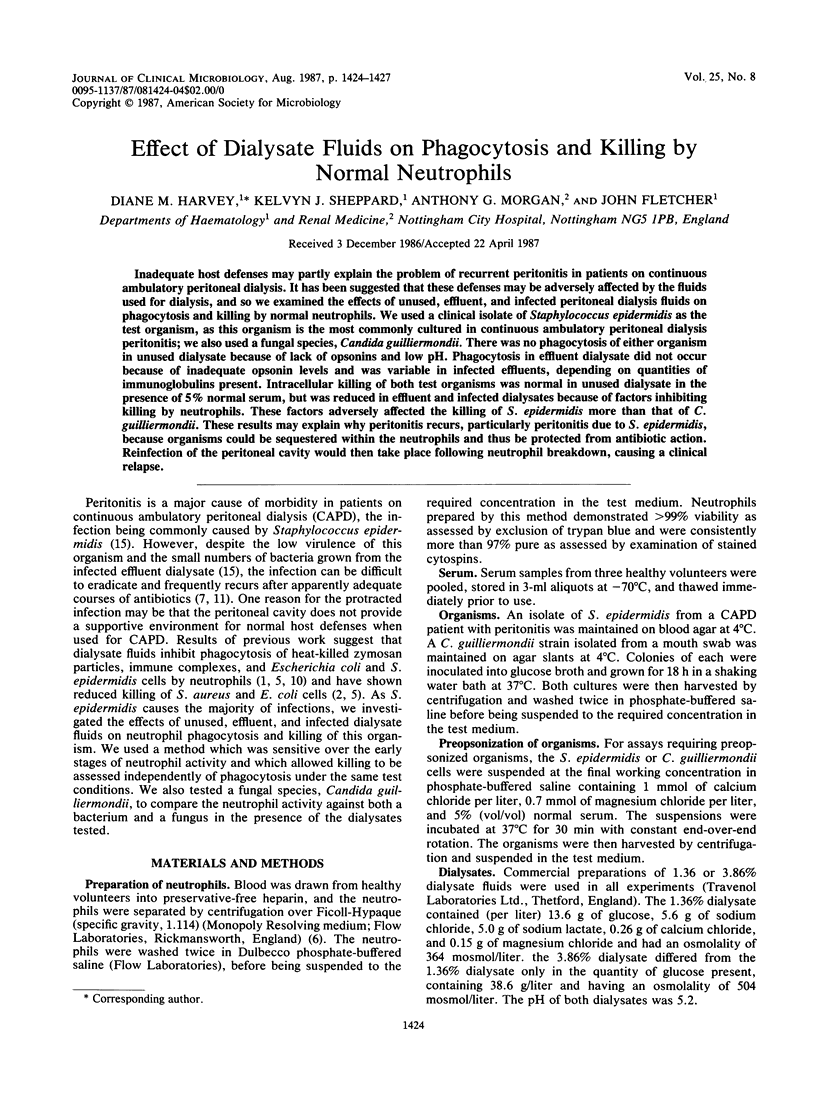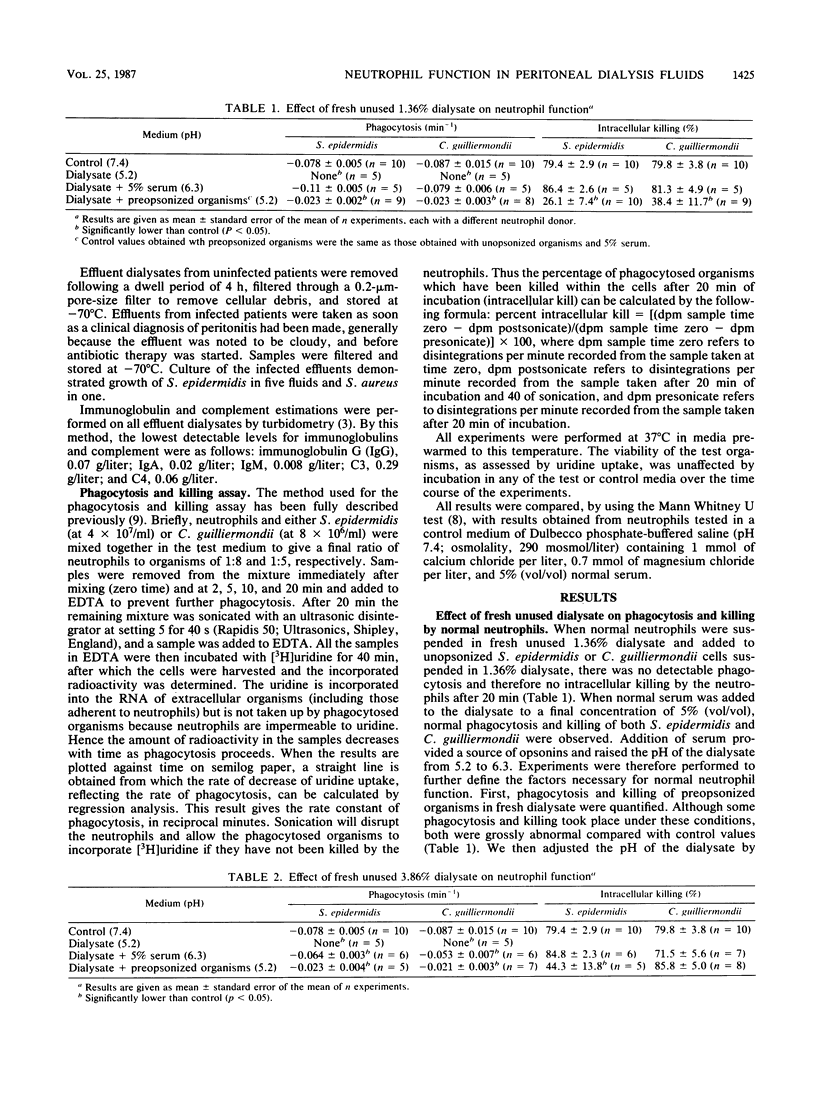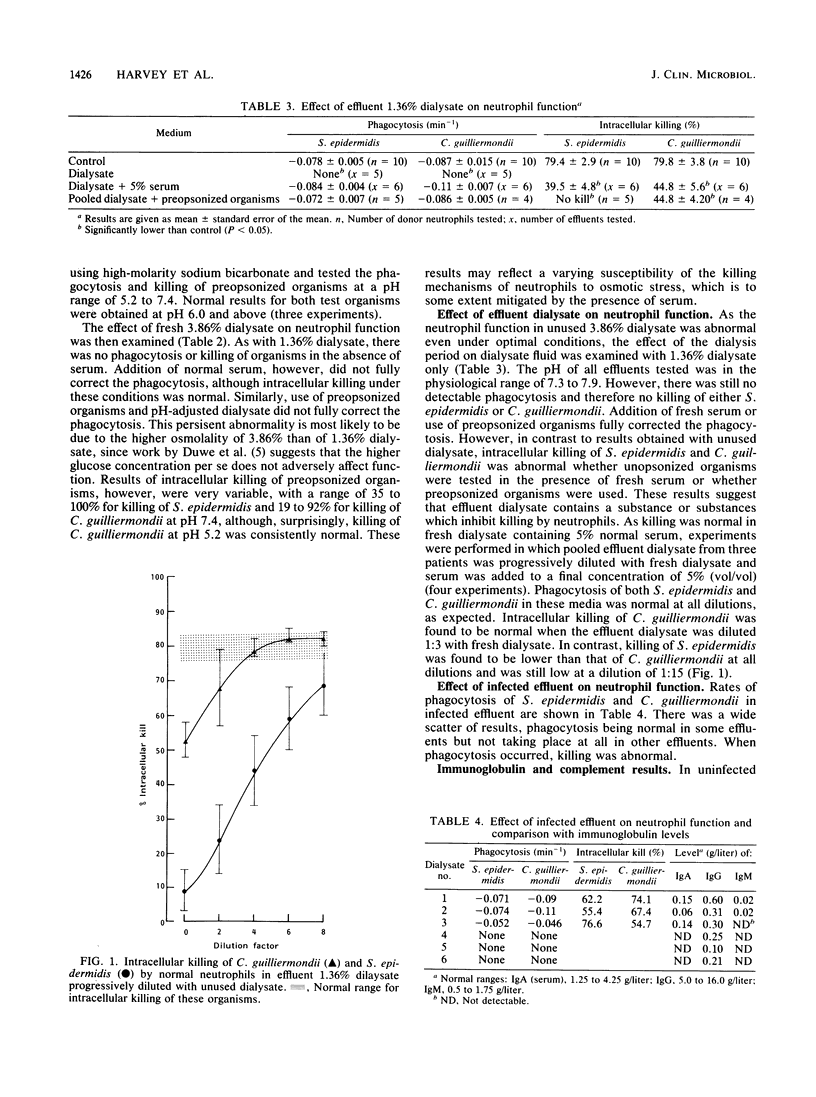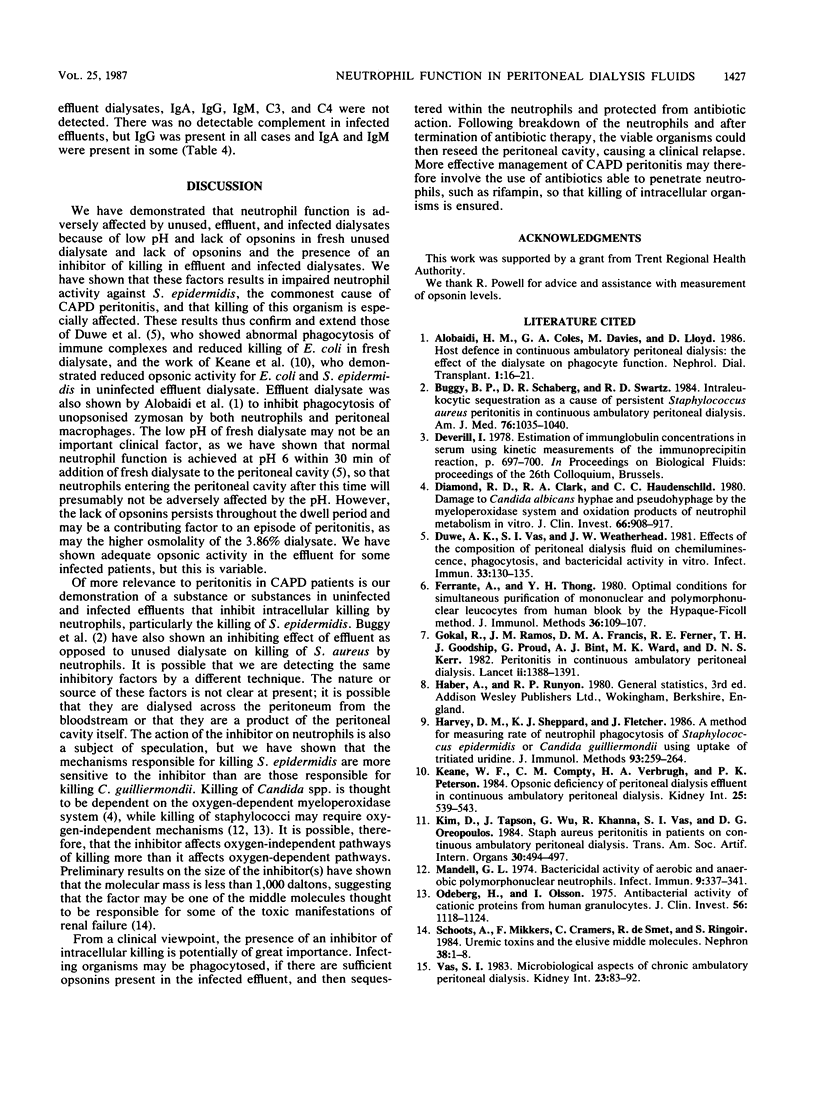Abstract
Inadequate host defenses may partly explain the problem of recurrent peritonitis in patients on continuous ambulatory peritoneal dialysis. It has been suggested that these defenses may be adversely affected by the fluids used for dialysis, and so we examined the effects of unused, effluent, and infected peritoneal dialysis fluids on phagocytosis and killing by normal neutrophils. We used a clinical isolate of Staphylococcus epidermidis as the test organism, as this organism is the most commonly cultured in continuous ambulatory peritoneal dialysis peritonitis; we also used a fungal species, Candida guilliermondii. There was no phagocytosis of either organism in unused dialysate because of lack of opsonins and low pH. Phagocytosis in effluent dialysate did not occur because of inadequate opsonin levels and was variable in infected effluents, depending on quantities of immunoglobulins present. Intracellular killing of both test organisms was normal in unused dialysate in the presence of 5% normal serum, but was reduced in effluent and infected dialysates because of factors inhibiting killing by neutrophils. These factors adversely affected the killing of S. epidermidis more than that of C. guilliermondii. These results may explain why peritonitis recurs, particularly peritonitis due to S. epidermidis, because organisms could be sequestered within the neutrophils and thus be protected from antibiotic action. Reinfection of the peritoneal cavity would then take place following neutrophil breakdown, causing a clinical relapse.
Full text
PDF



Selected References
These references are in PubMed. This may not be the complete list of references from this article.
- Alobaidi H. M., Coles G. A., Davies M., Lloyd D. Host defence in continuous ambulatory peritoneal dialysis: the effect of the dialysate on phagocyte function. Nephrol Dial Transplant. 1986;1(1):16–21. [PubMed] [Google Scholar]
- Buggy B. P., Schaberg D. R., Swartz R. D. Intraleukocytic sequestration as a cause of persistent Staphylococcus aureus peritonitis in continuous ambulatory peritoneal dialysis. Am J Med. 1984 Jun;76(6):1035–1040. doi: 10.1016/0002-9343(84)90854-4. [DOI] [PubMed] [Google Scholar]
- Diamond R. D., Clark R. A., Haudenschild C. C. Damage to Candida albicans hyphae and pseudohyphae by the myeloperoxidase system and oxidative products of neutrophil metabolism in vitro. J Clin Invest. 1980 Nov;66(5):908–917. doi: 10.1172/JCI109958. [DOI] [PMC free article] [PubMed] [Google Scholar]
- Duwe A. K., Vas S. I., Weatherhead J. W. Effects of the composition of peritoneal dialysis fluid on chemiluminescence, phagocytosis, and bactericidal activity in vitro. Infect Immun. 1981 Jul;33(1):130–135. doi: 10.1128/iai.33.1.130-135.1981. [DOI] [PMC free article] [PubMed] [Google Scholar]
- Ferrante A., Thong Y. H. Optimal conditions for simultaneous purification of mononuclear and polymorphonuclear leucocytes from human blood by the Hypaque-Ficoll method. J Immunol Methods. 1980;36(2):109–117. doi: 10.1016/0022-1759(80)90036-8. [DOI] [PubMed] [Google Scholar]
- Gokal R., Ramos J. M., Francis D. M., Ferner R. E., Goodship T. H., Proud G., Bint A. J., Ward M. K., Kerr D. N. Peritonitis in continuous ambulatory peritoneal dialysis. Laboratory and clinical studies. Lancet. 1982 Dec 18;2(8312):1388–1391. doi: 10.1016/s0140-6736(82)91282-x. [DOI] [PubMed] [Google Scholar]
- Harvey D. M., Sheppard K. J., Fletcher J. A method for measuring rate of neutrophil phagocytosis of Staphylococcus epidermidis or Candida guilliermondii using uptake of tritiated uridine. J Immunol Methods. 1986 Nov 6;93(2):259–264. doi: 10.1016/0022-1759(86)90198-5. [DOI] [PubMed] [Google Scholar]
- Keane W. F., Comty C. M., Verbrugh H. A., Peterson P. K. Opsonic deficiency of peritoneal dialysis effluent in continuous ambulatory peritoneal dialysis. Kidney Int. 1984 Mar;25(3):539–543. doi: 10.1038/ki.1984.51. [DOI] [PubMed] [Google Scholar]
- Kim D., Tapson J., Wu G., Khanna R., Vas S. I., Oreopoulos D. G. Staph aureus peritonitis in patients on continuous ambulatory peritoneal dialysis. Trans Am Soc Artif Intern Organs. 1984;30:494–497. [PubMed] [Google Scholar]
- Mandell G. L. Bactericidal activity of aerobic and anaerobic polymorphonuclear neutrophils. Infect Immun. 1974 Feb;9(2):337–341. doi: 10.1128/iai.9.2.337-341.1974. [DOI] [PMC free article] [PubMed] [Google Scholar]
- Odeberg H., Olsson I. Antibacterial activity of cationic proteins from human granulocytes. J Clin Invest. 1975 Nov;56(5):1118–1124. doi: 10.1172/JCI108186. [DOI] [PMC free article] [PubMed] [Google Scholar]
- Schoots A., Mikkers F., Cramers C., de Smet R., Ringoir S. Uremic toxins and the elusive middle molecules. Nephron. 1984;38(1):1–8. doi: 10.1159/000183269. [DOI] [PubMed] [Google Scholar]
- Vas S. I. Microbiologic aspects of chronic ambulatory peritoneal dialysis. Kidney Int. 1983 Jan;23(1):83–92. doi: 10.1038/ki.1983.15. [DOI] [PubMed] [Google Scholar]


